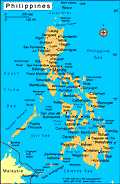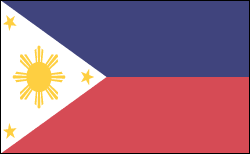Philippines
| Facts & Figures | |
|---|---|
President: Benigno "Noynoy" Aquino (2010)
Land area: 115,124 sq mi (298,171 sq km); total area: 115,830 sq mi (300,000 sq km)
Population (2010 est.): 99,900,177 (growth rate: 1.9%); birth rate: 25.7/1000; infant mortality rate: 19.9/1000; life expectancy: 71.4; density per sq mi: 791
Capital and largest city (2003 est.): Manila, 10,677,000 (metro. area), 1,581,082 (city proper)
Other large cities: Quezon City (2000 est.), 1,669,776 (part of Manila metro. area); Cebu (2003 est.), 761,900
Monetary unit: Peso
|
| |
Geography
The Philippine islands are an archipelago of over 7,000 islands lying about 500 mi (805 km) off the southeast coast of Asia. The overall land area is comparable to that of Arizona. Only about 7% of the islands are larger than one square mile, and only one-third have names. The largest are Luzon in the north (40,420 sq mi; 104,687 sq km), Mindanao in the south (36,537 sq mi; 94,631 sq km), and Samar (5,124 sq mi; 13,271 sq km). The islands are of volcanic origin, with the larger ones crossed by mountain ranges. The highest peak is Mount Apo (9,690 ft; 2,954 m) on Mindanao.
Government
Republic.
History
The Philippines' aboriginal inhabitants arrived from the Asian mainland around 25,000 BC They were followed by waves of Indonesian and Malayan settlers from 3000 BC onward. By the 14th century AD , extensive trade was being conducted with India, Indonesia, China, and Japan.
Ferdinand Magellan, the Portuguese navigator in the service of Spain, explored the Philippines in 1521. Twenty-one years later, a Spanish exploration party named the group of islands in honor of Prince Philip, who was later to become Philip II of Spain. Spain retained possession of the islands for the next 350 years.
The Philippines were ceded to the U.S. in 1899 by the Treaty of Paris after the Spanish-American War. Meanwhile, the Filipinos, led by Emilio Aguinaldo, had declared their independence. They initiated guerrilla warfare against U.S. troops that persisted until Aguinaldo's capture in 1901. By 1902, peace was established except among the Islamic Moros on the southern island of Mindanao.
The first U.S. civilian governor-general was William Howard Taft (1901–1904). The Jones Law (1916) established a Philippine legislature composed of an elective Senate and House of Representatives. The Tydings-McDuffie Act (1934) provided for a transitional period until 1946, at which time the Philippines would become completely independent. Under a constitution approved by the people of the Philippines in 1935, the Commonwealth of the Philippines came into being with Manuel Quezon y Molina as president.
On Dec. 8, 1941, the islands were invaded by Japanese troops. Following the fall of Gen. Douglas MacArthur's forces at Bataan and Corregidor, Quezon instituted a government-in-exile that he headed until his death in 1944. He was succeeded by Vice President Sergio Osmeña. U.S. forces under MacArthur reinvaded the Philippines in Oct. 1944 and, after the liberation of Manila in Feb. 1945, Osmeña reestablished the government.


0 (mga) komento:
Mag-post ng isang Komento